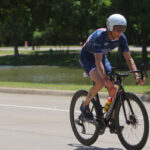The last post demonstrated how dancers may develop and implement an individualized Dance Imagery program. With hard work and commitment, dancers may be taking that extra step needed for them to dance their very best. But adhering to the program will not necessarily produce results. Consequently, this post will look at some factors that affect how well imagery works and offer some hints that will enable dancers to maximize the value of their Dance Imagery program.
Research indicates that there are several factors that influence the effectiveness of mental imagery. First, imagery perspective, i.e., whether dancers imagine themselves from an external or internal position. External imagery refers to the view as that of an outside observer or watching a movie. Internal imagery is characterized by the view from inside oneself, looking through one’s eyes. It is believed that the internal view produces better results because people are better able to reproduce all of their senses, whereas the external view relies mostly on the visual aspects of the imagery. The more senses that can be replicated, the more “real” the imagery will seem.
People have different imagery styles. Some are totally internal or external, while others use both. Dancers should use the style that is natural for them and then, if they are external, experiment with an internal view and see if they can develop the use of both perspectives. Other factors that seem to be related to effective imagery are the vividness and controllability of the images. The more vivid and clear the images are, the better able dancers will be to reproduce the thoughts, feelings, and sensations of actual performance. Dancers can be aware of what senses are used in dancing and include them in their imagery. During the imagery sessions, dancers can take time to focus on all of the senses, e.g., what sounds dancers hear, how their body feels, what they are thinking?
In order for dancers to develop vivid imagery, it helps to have a clear picture of what they look like dancing. The use of videos in training and performing is the best way to form clear self-images. A vivid picture of how dancers perform will aid them in learning new skills in their imagery by enabling dancers to see the difference between the way they do something now and the way they should do it. It will also help dancers understand better technical instructions offered by your coaches, enabling them to “see” what they mean.
Similarly, without some control over their images, making changes in the desired psychological or technical skill will be difficult. Once again, people vary in the controllability of their images. So if dancers find that their images are not clear or they are unable to control them immediately, they should not be discouraged. Imagery, like any other skill, can be developed and mastered with practice.
Whether dancers work on a technical or psychological skill may also influence how well the imagery works. Two factors seem to be important. First, the amount of practice time. Because technical skills have a physiological basis, i.e., the muscles are trained to react in a certain way, it takes more time and effort to learn or retrain the skill. So dancers should be prepared to spend extra time to learn and develop technical skills. Imagery can facilitate the learning process by being used before and during class or rehearsal or prior to performance. Dancers can then mentally rehearse the skill when the actual muscles are being used, thereby enhancing and reinforcing learning of the skill. In contrast, psychological skills such as self-confidence may not have that “set in granite” physiological foundation, so these areas may be easier to change.
Second, imagery can produce negative results if dancers rehearse the wrong skills in their imagery. As a result, it is necessary to know the correct way of performing the skill in order to substitute it for the old incorrect one. So a clear understanding and image of the correct way of performing the skill is important. Repeatedly watching films of top dancers will help develop a good image and aid in its carryover to learning.
The four areas that are worked on most in mental imagery are self-confidence, anxiety, concentration, and technical skills. This section will offer helpful hints that will assist dancers in getting the most out of their imagery program.
- Self-confidence – The two things to focus on here are positive self-statements and successful imagery. Thinking positively will instill in dancers a belief that they can be successful, enabling them to approach the imagery in a constructive way. Then seeing themselves succeeding in their imagery will reinforce those initial beliefs that they can dance well. So a spiraling effect results, whereby positive thinking improves dancers’ imagery which, in turn, increases their self-confidence.
- Anxiety – The relaxation exercises discussed in an earlier article are essential for becoming aware of and controlling excessive anxiety. Throughout the imagery sessions, dancers should monitor their bodies: Are they nervous or tense? If dancers are, they can use the breathing and cuewords to relax. However, dancers should only use the relaxation exercises if they feel that the anxiety is hurting their imagery. One goal of imagery is to familiarize the body with the feelings experienced during performance. Since a moderate amount of anxiety enables the body to perform at a high level, some anxiety is expected and desired. Dancers should think back to their best performances and see if they can pinpoint the anxiety level that enabled them to dance their best. Then during imagery, dancers may use the relaxation exercises to reach and maintain that level.
- Concentration – Problems with concentration result from either focusing on the wrong things, too many, or too few things during a performance. First, it is important to know what should be concentrated on, e.g., the technique, the space, the music, the feeling, and what should not, e.g., the audience and extraneous thoughts unrelated to the performance. Second, during imagery dancers can narrow their focus to the appropriate areas. Dancers can imagine, for instance, that they are dancing in a tunnel with only the stage in sight, thereby blocking out unwanted distractions. One of the great advantages of imagery as compared to real practice is that dancers do not have a lot of distractions, so they can concentrate on those areas that they want to work on.
- Technical skills – Often it is difficult to make technical changes and correct bad habits that have been done for years. Sometimes people just can not seem to change their images. One way dancers can establish control and facilitate change is to begin their imagery in slow motion, frame by frame (using the film analogy). This enables dancers to concentrate on the different parts of the skill instead of the whole thing all at once. With each frame, dancers can freeze themselves in the position that they want to be in, then move on to the next frame. As control develops, the imagery changes, and the new skill is learned. Once learning begins, the imagery can be speeded up and the components of the skill can be combined.
By building a personalized Dance Imagery program that considers the above issues such as vividness and controllability, dancers can be sure that they are utilizing imagery in such a fashion that will maximize the benefits that accrue from its use.


